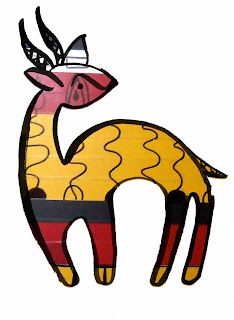From my experimentations and developments I have created these four illustrations in response to the African Folk Tale:
'The Story of a Hunter and his Antelope Wife.'
Explanation of the
Final Outcomes:
1st
image: layered Antelope Skin on a green
background. Green represents vegetation and as the first scene takes place in
the forest where the antelopes take off they’re skin, this represents the
environment.
2nd
image: the characters of the Antelope Woman and
the hunter. I used a pale blue background and this means peace and harmony,
portraying the meeting of these two characters leads to confiding in each other
and proposed marriage. Male and females wear different dominant colour in Kente
Cloth, therefore the colours in each character are based from this and also the line
in the patterns are white as this means balance. This conveys the meeting of
the characters.
3rd
image – the Skin hanging from the roof and the
pot. The background for this image is a red/orange colour because red means
betrayal and this scene portrays how the hunter broke his promise and told the
antelope woman’s secret to his first wife.
4th
image – the woman turns back into an antelope
and changes her three children too. Unlike the other images, I have outlined
the antelopes in black. Black represents maturity and this represents how the
young children have grown up and now turned into young male antelopes. I have
used the same pattern to fill the female antelope as in the second image of the
woman to show they are the same character. I used bold greens and blue colours
for the other antelopes, as they are the colours that males wear. The
background is a brown meaning the earth – showing how the antelopes will now
leave and return to the land where they came from.



















































